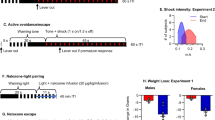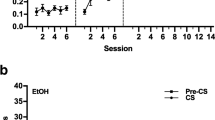Abstract
In one experiment, key pressing of rats was maintained under a fixed-ratio schedule of food presentation in a first daily session in one environmental situation, and interruption of a photobeam was maintained under a continuous shock avoidance schedule in a second daily session in another environmental situation. After receiving acute injections of the cannabinoidl-nantradol (0.01–0.3 mg/kg), rats received daily administration of a rate-decreasing dose of the drugafter the second session, thenbefore the second session, and thenbefore the first session. Tolerance that developed to decreased avoidance responding in the second daily session did not extend to decreased fixed-ratio responding in the first daily session, but was specific to circumstances coinciding with the pharmacological actions ofl-nantradol. In a second experiment, lever pressing of squirrel monkeys was maintained under an identical fixed-interval schedule of food delivery in two separate daily sessions in different experimental situations. After receiving once-weekly acute injections of morphine (0.3–3.0 mg/kg), monkeys received daily administration of a rate-decreasing dose of morphine in a counter-balanced orderbefore each session. Just as for experiment 1, tolerance that developed in the environment coinciding with the pharmacological actions of morphine did not immediately generalize to operants in the other environmental situation. Instead, tolerance depended on both pharmacologic action as well as concurrently operating behavioral processes.
Similar content being viewed by others
References
Advokat C (1981) Analgesic tolerance produced by morphine pellets is facilitated by analgesic test. Pharmacol Biochem Behav 14:133–137
Balster RL (1985) Behavioral studies of tolerance and dependence. In: Seiden LS, Balster RL (eds) Neurology and neurobiology, volume 13: Behavioral pharmacology-the current status. Liss, New York, pp 403–418
Barrett JE, Glowa JR, Nader MA (1989) Behavioral and pharmacological history as determinants of tolerance- and sensitization-like phenomena in drug action. In: Goudie AJ, Emmett-Oglesby MW (eds) Psychoactive drugs. Humana Press, Clifton, New Jersey, pp 181–219
Bickel WK, Kelly TH (1988) The relationship of stimulus control to the treatment of substance abuse. In: Ray BA (ed) NIDA Monogr 84. NIDA, Washington DC, pp 122–140
Blackman DE (1989) Behavioral tolerance and sensitization-Definitions and explanations. In: Goudie AJ, Emmett-Oglesby MW (eds) Psychoactive drugs. Humana Press, Cliffton, New Jersey, pp 521–546
Campbell L, Seiden LS (1973) Performance influence on the development of tolerance tod-amphetamine. Pharmacol Biochem Behav 1:703–708
Coxen M, Carney JM, Seale TW (1989) Environmental cues influence cocaine- and procaine-mediated conditioned place preference. Society for Neuroscience Meeting: Abstract 1 (Abstract)
Epstein LH, Caggiula AR, Stiller R (1989) Environment-specific tolerance to nicotine. Psychopharmacolgy 97:235–237
Goldberg SR, Schuster CR (1970) Conditioned nalorphine-induced abstinence changes: persistence in post morphine-dependent monkeys. J Exp Anal Behav 14:33–46
Goldstein AL, Aronow L, Kalman SM (1974) Principles of drug action: basis of pharmacology. Wiley, New York
Hake DF, Azrin NH (1963) An apparatus for delivering pain shock to monkeys. J Exp Anal Behav 6:297–298
Kalant H, Leblanc AE, Gibbins RJ (1971) Tolerance to and dependence on some non-opiate psychotropic drugs. Pharmacol Rev 23:135–191
Kayan S, Ferguson RK, Mitchell CL (1973) An investigation of pharmacologic and behavioral tolerance to morphine in rats. J Pharmacol Exp Ther 185:300–306
Leblanc AE, Gibbins RJ, Kalant H (1975) Generalization of behaviorally augmented tolerance to ethanol and its relation to physical dependence. Psychopharmacology 44:241–246
Leblanc AE, Kalant H, Gibbins RJ (1976) Acquisition and loss of behaviorally augmented tolerance to ethanol in the rat. Psychopharmacology 48:153–158
McKearney JW (1974) Effects ofd-amphetamine, morphine and chlorpromazine on responding under fixed-interval schedules of food presentation or electric shock presentation. J Pharmacol Exp Ther 190:141–153
Sannerud CA, Young AM (1986) Modification of morphine tolerance by behavioral variables. J Pharmacol Exp Ther 237:75–81
Schindler CW, Katz JL, Goldberg SR (1988) The use of second-order schedules to study the influence of environmental stimuli on drug-seeking behavior. In: Ray BA (ed) Learning factors in substance abuse. NIDA Monogr 84, Washington DC, pp 180–195
Schuster CR, Dockens WS, Woods JH (1966) Behavioral variables affecting the development of amphetamine tolerance. Psychopharmacologia 9:170–182
Sidman M (1953) Avoidance conditioning with brief shock and no exteroceptive warning signal. Science 118:157–158
Siegel S (1977) A Pavlovian conditioning analysis of morphine tolerance. J Exp Psychol 3:1–13
Siegel S (1988) Drug anticipation and the treatment of dependence. In: Ray BA (ed) Learning factors in substance abuse. NIDA Monograph 84, Washington DC, pp 1–24
Siegel S (1989) Pharmacological conditioning and drug effects. In: Goudie AJ, Emmett-Oglesby MW (eds) Psychoactive drugs. Humana Press, Clifton, New Jersey, pp 115–180
Smith JB (1979) Behavioral influences on tolerance to the effects of morphine on schedule-controlled behavior. Psychopharmacology 66:105–107
Smith JB (1985a) Effects of single and repeated daily injections of morphine, clonidine, andl-nantradol on avoidance responding of rats. Psychopharmacology 87:425–429
Smith JB (1985b) Effects of single and repeated daily injections of morphine, clonidine, andl-nantradol on responding of squirrel monkeys under escape titration. J Pharmacol Exp Ther 234:94–99
Smith JB (1986a) Effects of fixed-ratio length on the development of tolerance to decreased responding byl-nantradol. Psychopharmacology 90:259–262
Smith JB (1986b) Effects of chronically administeredd-amphetamine on spaced responding maintained under multiple and single-component schedules. Psychopharmacology 88:296–300
Smith JB (1988) Environmental specificity of tolerance to behavioral effects of clonidine. Fed Proc 2
Smith JB, McKearney JW (1977) Changes in the rate-increasing effects ofd-amphetamine and pentobarbital by response consequences. Psychopharmacology 53:151–157
Vogel-Sprott M, Sdao-Jarvie K (1989) Learning alcohol tolerance: the contribution of response expectancies. Psychopharmacology 98:289–296
Wikler A (1965) Conditioning factors in opiate addiction and relapse. In: Wilner DM, Kassebaum GG (eds) Narcotics. McGraw Hill, New York, pp 85–100
Wikler A (1980) Opioid dependence mechanisms and treatment. Plenum Press, New York
Author information
Authors and Affiliations
Additional information
Animals used in this study were maintained in accordance with guidelines of the Animal Care Committee of the Worcester Foundation for Experimental Biology and of the “Guide for Care and Use of Laboratory Animals” of the Institute of Laboratory Animal Resources, National Research Council, Department of Health, Education and Welfare, Publication Number (NIH)85-23, revised 1985
Rights and permissions
About this article
Cite this article
Smith, J.B. Situational specificity of tolerance to decreased operant responding by morphine andl-nantradol. Psychopharmacology 103, 115–120 (1991). https://doi.org/10.1007/BF02244085
Received:
Revised:
Issue Date:
DOI: https://doi.org/10.1007/BF02244085




